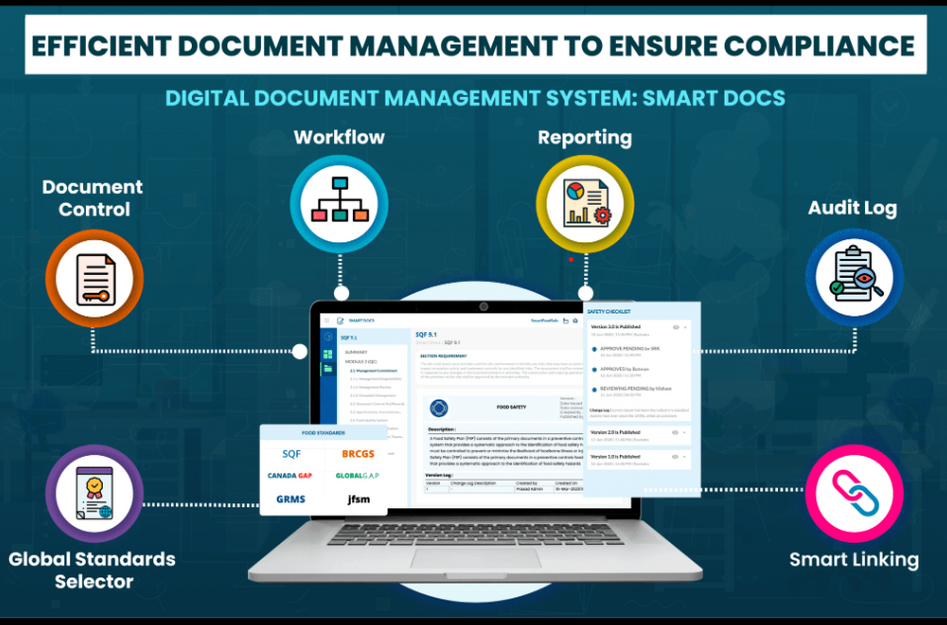
Do you know in the language of auditing, if you did not document something, it simply means you did not do it?
Compliance with food safety and quality requirements is crucial for success in the food industry. Now, picture a world where document compliance is seamless, efficient, and auditable. This can be made a reality through the power of digital document management systems. By embracing digital food safety and quality compliance management, food companies can experience unparalleled peace of mind knowing that your firm’s documentation is aligned with industry regulatory standards.
The principle of “saying what you do and doing what you say” is a fundamental differentiator between a thriving, efficient organization and one that remains stagnant due to overreliance on traditional methods and systems. This phrase encapsulates the essence of integrity in business practices, highlighting the significance of following through on commitments. Given below is a breakdown of the different elements encompassed in this concept.
SAY AS YOU DO – Document information on policies, procedures, and work instructions
DO AS YOU SAY – Follow record keeping as required in the documents
DUE DILIGENCE – Demonstrate due diligence with evidence
In the realm of document compliance, paper-based systems often fall short of translating intentions into actions. Digitizing document management empowers businesses to bridge the gap between what is said and what is done. With the digital transformation of document management, companies can seamlessly align their words and actions through real-time data capture, automated tracking, centralized repositories, and streamlined workflows to establish accountability and consistent compliance throughout their operations.
Despite the multitude of technological advancements that have revolutionized various facets of our lives, it is somewhat perplexing that many businesses continue to depend on paper-based document management systems. Let us look at some significant drawbacks of utilizing paper-based document management and how they affect the compliance scenario:
1. Limited Accessibility
Physical documents stored in filing cabinets or storage rooms hinder employee access. Lack of remote access causes delays and hampers productivity. Mobility limitations in paper-based systems impact compliance efforts, making it challenging to meet regulatory requirements.
2. Risks of Human Error
Manual handling of paper-based documents increases the chances of human error. Misfiling, lost documents, and accidental damage jeopardizes compliance. Paper documents degrade over time, leading to illegibility and loss of critical information. Manual data entry amplifies inaccuracies, resulting in compliance violations and legal consequences.
3. Revision Management
Paper-based systems struggle to track changes, revisions, and updates accurately. This creates confusion in determining the most up-to-date version. Inadequate version control poses risks to compliance requirements, making it challenging to depict the accurate document version during audits or regulatory inquiries.
4. Lacking Audit Trails
The absence of robust audit trails hinders the effective tracking of document changes. A clear record of revisions is necessary to validate compliance efforts and avoid violations and legal consequences. Without a reliable audit trail, organizations struggle to prove adherence to regulations, risking their compliance status.
5. Retrieval & Searchability
Locating specific documents in paper-based files is time-consuming and error-prone. Manual searching is slow and inefficient. Lack of indexing and search functionality hampers efficiency and increases non-compliance risks. Compliance requirements demand quick access to specific documents, impeded by paper-based systems.
6. Collaboration Capabilities
Paper-based document management restricts communication and coordination. Editing paper documents for collaboration is cumbersome. Multiple copies must be printed, edited individually, and exchanged, leading to a time-intensive process. This limits efficient collaboration between department heads and slows down work progress.
7. Environmental Impact
Paper-based systems have a significant environmental impact due to paper, ink, and energy consumption. They hinder compliance with environmental regulations, posing challenges to sustainability efforts.
8. Recurring Costs
Implementing paper-based systems incurs additional expenses on office supplies like printers, photocopiers, and stationery. Physical storage of paper documents requires filing cabinets, storage rooms, and extra office space, adding to costs and becoming a financial burden for organizations.
Imagine having a powerful tool that helps your organization seamlessly process, capture, store, manage, and track documents. This is exactly what a document management system does. A document management system empowers you to develop stable, predictable, and measurable processes to enable quick access to the exact information you are looking for whenever and wherever you need it. You can bid farewell to the chaos of paper files and welcome an organized, efficient, and digital way of handling your critical business information with document management software.
How Smart Docs Stand Out as a Digital Document Management System?
Smart Food Safe‘s Smart Docs is a digital document management software developed to optimize the entire document management process and maintain document compliance with global quality and food safety standards.
Systematic Document Control
Effortlessly create and edit documents, upload custom files, and link internal/external documents. Seamlessly integrate with cloud storage for simplified and organized documentation processes.
Integrated Global Regulatory Standards
Choose from a range of global Quality & Food Safety standards such as SQF, BRCGS, IFS, etc. Access a library of standard templates, migrate to the latest versions with a click, and stay compliant with 21 CPR Part 11 Document Compliance.
Centralized Document Repository
Organize and store all documents in a centralized ecosystem. Customize folder categorization, utilize versatile search filters, and securely access documents from anywhere for uninterrupted business operations.
Scheduling Tasks
Ensure timely compliance by scheduling review and approval tasks, syncing them with users' calendars, and receiving email reminders. Maintain a color-coded status history for comprehensive compliance management.
Automated Document Workflow
Boost productivity with an automated and configurable workflow. Manage document lifecycles, maintain approval and rejection flows, and execute real-time document actions across your business operations.
Traceable Audit Log
Establish user roles to track and report the complete history of document modifications, approvals, and rejections. Gain visibility of the document lifecycle through an audit log, document versioning, and change log summaries.
Smart Linking
Link relevant policies, procedures, and records from other modules such as Smart Record and Smart Supplier. Meet regulatory requirements for due diligence and compliance.
_1.png)